Road Extraction from Remote Sensing Imagery with Spatial Attention Based on Swin Transformer
Abstract
1. Introduction
- We propose a SASwin Transformer network that jointly learns global and local feature information from satellite images to enhance road segmentation.
- We have developed an SMLP module that aggregates rich spatial context information by performing linear transformations in three dimensions of the image. Compared to the original MLP module, this SMLP module reduces computational complexity.
- We have designed an SSA module to extract effective spatial context information. Compared to the original MSA module, it reduces unnecessary computations and avoids interference from irrelevant regions.
- Compared to other advanced methods, our approach achieves significant improvements in segmentation accuracy. On two publicly available datasets, our method outperforms D-LinkNet by 1.88% and 1.84% in terms of the IoU metric.
2. Related Work
2.1. Conventional Methods
2.2. CNN-Based Methods
2.3. Transformer-Based Methods
2.4. Combining CNN with Transformer
3. The Proposed SASwin Transformer Method
3.1. Overall Network Structure
3.1.1. Encoder Module
3.1.2. Bridge Module
3.1.3. Decoder Module
3.2. SASwin Transformer Blocks
3.3. Spatial MLP Module
3.4. Spatial Self-Attention Module
3.5. Loss Function
4. Experimental Results and Analysis
4.1. Datasets
4.1.1. Massachusetts Dataset
4.1.2. DeepGlobe Dataset
4.2. Evaluation Metrics
4.3. Implementation Setting
4.4. Experimental Results and Analysis
4.4.1. The Results of the Massachusetts Dataset
4.4.2. The Results of the DeepGlobe Dataset
4.5. Ablation Studies
4.6. Student’s T-Test
5. Conclusions
Author Contributions
Funding
Data Availability Statement
Conflicts of Interest
References
- Li, Q.; Chen, L.; Li, M.; Shaw, S.L.; Nüchter, A. A Sensor-Fusion Drivable-Region and Lane-Detection System for Autonomous Vehicle Navigation in Challenging Road Scenarios. IEEE Trans. Veh. Technol. 2014, 63, 540–555. [Google Scholar] [CrossRef]
- Du, B.; Zhang, M.; Zhang, L.; Hu, R.; Tao, D. PLTD: Patch-Based Low-Rank Tensor Decomposition for Hyperspectral Images. IEEE Trans. Multimed. 2017, 19, 67–79. [Google Scholar] [CrossRef]
- Barzohar, M.; Cooper, D. Automatic finding of main roads in aerial images by using geometric-stochastic models and estimation. In Proceedings of the IEEE Conference on Computer Vision and Pattern Recognition, New York, NY, USA, 15–17 June 1993; pp. 459–464. [Google Scholar] [CrossRef]
- Laptev, I.; Mayer, H.; Lindeberg, T.; Eckstein, W.; Steger, C.; Baumgartner, A. Automatic extraction of roads from aerial images based on scale space and snakes. Mach. Vis. Appl. 2000, 12, 23–31. [Google Scholar] [CrossRef]
- Chai, D.; Förstner, W.; Lafarge, F. Recovering Line-Networks in Images by Junction-Point Processes. In Proceedings of the 2013 IEEE Conference on Computer Vision and Pattern Recognition, Portland, OR, USA, 23–28 June 2013; pp. 1894–1901. [Google Scholar] [CrossRef]
- Long, J.; Shelhamer, E.; Darrell, T. Fully convolutional networks for semantic segmentation. In Proceedings of the IEEE Conference on Computer Vision and Pattern Recognition, CVPR 2015, Boston, MA, USA, 7–12 June 2015; IEEE Computer Society: Washington, DC, USA, 2015; pp. 3431–3440. [Google Scholar] [CrossRef]
- Ronneberger, O.; Fischer, P.; Brox, T. U-Net: Convolutional Networks for Biomedical Image Segmentation. In Proceedings of the Medical Image Computing and Computer-Assisted Intervention-MICCAI 2015—18th International Conference, Munich, Germany, 5–9 October 2015; Proceedings, Part III; Lecture Notes in Computer Science. Navab, N., Hornegger, J., III, Wells, M.W., Frangi, A.F., Eds.; Springer: Berlin/Heidelberg, Germany, 2015; Volume 9351, pp. 234–241. [Google Scholar] [CrossRef]
- Chen, L.; Papandreou, G.; Schroff, F.; Adam, H. Rethinking Atrous Convolution for Semantic Image Segmentation. arXiv 2017, arXiv:1706.05587. [Google Scholar] [CrossRef]
- Zhou, L.; Zhang, C.; Wu, M. D-LinkNet: LinkNet With Pretrained Encoder and Dilated Convolution for High Resolution Satellite Imagery Road Extraction. In Proceedings of the 2018 IEEE Conference on Computer Vision and Pattern Recognition Workshops, CVPR Workshops 2018, Salt Lake City, UT, USA, 18–22 June 2018; Computer Vision Foundation/IEEE Computer Society: Washington, DC, USA, 2018; pp. 182–186. [Google Scholar] [CrossRef]
- Chen, L.C.; Papandreou, G.; Kokkinos, I.; Murphy, K.; Yuille, A.L. DeepLab: Semantic Image Segmentation with Deep Convolutional Nets, Atrous Convolution, and Fully Connected CRFs. IEEE Trans. Pattern Anal. Mach. Intell. 2018, 40, 834–848. [Google Scholar] [CrossRef] [PubMed]
- Cao, F.; Bao, Q. A Survey on Image Semantic Segmentation Methods with Convolutional Neural Network. In Proceedings of the 2020 International Conference on Communications, Information System and Computer Engineering (CISCE), Kuala Lumpur, Malaysia, 3–5 July 2020; pp. 458–462. [Google Scholar] [CrossRef]
- Yamashita, T.; Furukawa, H.; Fujiyoshi, H. Multiple Skip Connections of Dilated Convolution Network for Semantic Segmentation. In Proceedings of the 2018 25th IEEE International Conference on Image Processing (ICIP), Athens, Greece, 7–10 October 2018; pp. 1593–1597. [Google Scholar] [CrossRef]
- Mnih, V.; Hinton, G.E. Learning to Detect Roads in High-Resolution Aerial Images. In Proceedings of the Computer Vision-ECCV 2010-11th European Conference on Computer Vision, Heraklion, Crete, Greece, 5–11 September 2010; Proceedings, Part VI; Lecture Notes in Computer Science. Daniilidis, K., Maragos, P., Paragios, N., Eds.; Springer: Berlin/Heidelberg, Germany, 2010; Volume 6316, pp. 210–223. [Google Scholar] [CrossRef]
- Cheng, G.; Wang, Y.; Xu, S.; Wang, H.; Xiang, S.; Pan, C. Automatic Road Detection and Centerline Extraction via Cascaded End-to-End Convolutional Neural Network. IEEE Trans. Geosci. Remote Sens. 2017, 55, 3322–3337. [Google Scholar] [CrossRef]
- Panboonyuen, T.; Jitkajornwanich, K.; Lawawirojwong, S.; Srestasathiern, P.; Vateekul, P. Road Segmentation of Remotely-Sensed Images Using Deep Convolutional Neural Networks with Landscape Metrics and Conditional Random Fields. Remote Sens. 2017, 9, 680. [Google Scholar] [CrossRef]
- Ma, J.; Wu, L.; Tang, X.; Zhang, X.; Zhu, C.; Ma, J.; Jiao, L. Hyperspectral Image Classification Via Multi-Scale Encoder-Decoder Network. In Proceedings of the IGARSS 2020-2020 IEEE International Geoscience and Remote Sensing Symposium, Waikoloa, HI, USA, 26 September–2 October 2020; pp. 1283–1286. [Google Scholar] [CrossRef]
- Nakazawa, T.; Kulkarni, D.V. Anomaly Detection and Segmentation for Wafer Defect Patterns Using Deep Convolutional Encoder–Decoder Neural Network Architectures in Semiconductor Manufacturing. IEEE Trans. Semicond. Manuf. 2019, 32, 250–256. [Google Scholar] [CrossRef]
- Yan, F.; Yan, B.; Pei, M. Dual Transformer Encoder Model for Medical Image Classification. In Proceedings of the 2023 IEEE International Conference on Image Processing (ICIP), Kuala Lumpur, Malaysia, 8–11 October 2023; pp. 690–694. [Google Scholar] [CrossRef]
- Gai, L.; Chen, W.; Gao, R.; Chen, Y.W.; Qiao, X. Using Vision Transformers in 3-D Medical Image Classifications. In Proceedings of the 2022 IEEE International Conference on Image Processing (ICIP), Bordeaux, France, 16–19 October 2022; pp. 696–700. [Google Scholar] [CrossRef]
- Lu, D.; Xie, Q.; Gao, K.; Xu, L.; Li, J. 3DCTN: 3D Convolution-Transformer Network for Point Cloud Classification. IEEE Trans. Intell. Transp. Syst. 2022, 23, 24854–24865. [Google Scholar] [CrossRef]
- Meng, X.; Yang, Y.; Wang, L.; Wang, T.; Li, R.; Zhang, C. Class-Guided Swin Transformer for Semantic Segmentation of Remote Sensing Imagery. IEEE Geosci. Remote Sens. Lett. 2022, 19, 1–5. [Google Scholar] [CrossRef]
- Cheng, H.X.; Han, X.F.; Xiao, G.Q. TransRVNet: LiDAR Semantic Segmentation With Transformer. IEEE Trans. Intell. Transp. Syst. 2023, 24, 5895–5907. [Google Scholar] [CrossRef]
- Bastani, F.; He, S.; Abbar, S.; Alizadeh, M.; Balakrishnan, H.; Chawla, S.; Madden, S.; DeWitt, D. RoadTracer: Automatic Extraction of Road Networks from Aerial Images. In Proceedings of the 2018 IEEE/CVF Conference on Computer Vision and Pattern Recognition, Salt Lake City, UT, USA, 18–22 June 2018; pp. 4720–4728. [Google Scholar] [CrossRef]
- Tan, Y.; Gao, S.; Li, X.; Cheng, M.; Ren, B. VecRoad: Point-Based Iterative Graph Exploration for Road Graphs Extraction. In Proceedings of the 2020 IEEE/CVF Conference on Computer Vision and Pattern Recognition, CVPR 2020, Seattle, WA, USA, 13–19 June 2020; pp. 8907–8915. [Google Scholar] [CrossRef]
- He, S.; Bastani, F.; Jagwani, S.; Alizadeh, M.; Balakrishnan, H.; Chawla, S.; Elshrif, M.M.; Madden, S.; Sadeghi, M.A. Sat2Graph: Road Graph Extraction Through Graph-Tensor Encoding. In Proceedings of the Computer Vision-ECCV 2020-16th European Conference, Glasgow, UK, 23–28 August 2020; Proceedings, Part XXIV; Lecture Notes in Computer Science. Vedaldi, A., Bischof, H., Brox, T., Frahm, J., Eds.; Springer: Berlin/Heidelberg, Germany, 2020; Volume 12369, pp. 51–67. [Google Scholar] [CrossRef]
- Bahl, G.; Bahri, M.; Lafarge, F. Single-Shot End-to-end Road Graph Extraction. In Proceedings of the 2022 IEEE/CVF Conference on Computer Vision and Pattern Recognition Workshops (CVPRW), New Orleans, LA, USA, 18–24 June 2022; pp. 1402–1411. [Google Scholar]
- Xu, Z.; Liu, Y.; Gan, L.; Sun, Y.; Wu, X.; Liu, M.; Wang, L. RNGDet: Road Network Graph Detection by Transformer in Aerial Images. IEEE Trans. Geosci. Remote Sens. 2022, 60, 1–12. [Google Scholar] [CrossRef]
- Liu, Z.; Lin, Y.; Cao, Y.; Hu, H.; Wei, Y.; Zhang, Z.; Lin, S.; Guo, B. Swin Transformer: Hierarchical Vision Transformer using Shifted Windows. In Proceedings of the 2021 IEEE/CVF International Conference on Computer Vision (ICCV), Montreal, BC, Canada, 10–17 October 2021; pp. 9992–10002. [Google Scholar] [CrossRef]
- He, K.; Zhang, X.; Ren, S.; Sun, J. Deep Residual Learning for Image Recognition. In Proceedings of the 2016 IEEE Conference on Computer Vision and Pattern Recognition, CVPR 2016, Las Vegas, NV, USA, 27–30 June 2016; IEEE Computer Society: Washington, DC, USA, 2016; pp. 770–778. [Google Scholar] [CrossRef]
- He, Y.; Wang, H.; Zhang, B. Color based road detection in urban traffic scenes. In Proceedings of the 2003 IEEE International Conference on Intelligent Transportation Systems, Shanghai, China, 12–15 October 2003; Volume 1, pp. 730–735. [Google Scholar] [CrossRef]
- Zhang, Q.; Couloigner, I. Benefit of the angular texture signature for the separation of parking lots and roads on high resolution multi-spectral imagery. Pattern Recognit. Lett. 2006, 27, 937–946. [Google Scholar] [CrossRef]
- Wegner, J.D.; Montoya-Zegarra, J.A.; Schindler, K. A Higher-Order CRF Model for Road Network Extraction. In Proceedings of the 2013 IEEE Conference on Computer Vision and Pattern Recognition, Portland, OR, USA, 23–28 June 2013; IEEE Computer Society: Washington, DC, USA, 2013; pp. 1698–1705. [Google Scholar] [CrossRef]
- Song, M.; Civco, D.L. Road Extraction Using SVM and Image Segmentation. Photogramm. Eng. Remote Sens. 2004, 70, 1365–1371. [Google Scholar] [CrossRef]
- Krizhevsky, A.; Sutskever, I.; Hinton, G.E. ImageNet classification with deep convolutional neural networks. Commun. ACM 2012, 60, 84–90. [Google Scholar] [CrossRef]
- Badrinarayanan, V.; Kendall, A.; Cipolla, R. SegNet: A Deep Convolutional Encoder-Decoder Architecture for Image Segmentation. IEEE Trans. Pattern Anal. Mach. Intell. 2017, 39, 2481–2495. [Google Scholar] [CrossRef]
- Zhang, Z.; Liu, Q.; Wang, Y. Road Extraction by Deep Residual U-Net. IEEE Geosci. Remote Sens. Lett. 2018, 15, 749–753. [Google Scholar] [CrossRef]
- Demir, I.; Koperski, K.; Lindenbaum, D.; Pang, G.; Huang, J.; Basu, S.; Hughes, F.; Tuia, D.; Raskar, R. DeepGlobe 2018: A Challenge to Parse the Earth through Satellite Images. In Proceedings of the 2018 IEEE/CVF Conference on Computer Vision and Pattern Recognition Workshops (CVPRW), Salt Lake City, UT, USA, 18–22 June 2018; pp. 172–17209. [Google Scholar] [CrossRef]
- Wei, Y.; Zhang, K.; Ji, S. Simultaneous Road Surface and Centerline Extraction From Large-Scale Remote Sensing Images Using CNN-Based Segmentation and Tracing. IEEE Trans. Geosci. Remote Sens. 2020, 58, 8919–8931. [Google Scholar] [CrossRef]
- Cao, X.; Zhang, K.; Jiao, L. CSANet: Cross-Scale Axial Attention Network for Road Segmentation. Remote Sens. 2023, 15, 3. [Google Scholar] [CrossRef]
- Vaswani, A.; Shazeer, N.M.; Parmar, N.; Uszkoreit, J.; Jones, L.; Gomez, A.N.; Kaiser, L.; Polosukhin, I. Attention is All you Need. In Proceedings of the NIPS, Long Beach, CA, USA, 4–9 December 2017. [Google Scholar]
- Dosovitskiy, A.; Beyer, L.; Kolesnikov, A.; Weissenborn, D.; Zhai, X.; Unterthiner, T.; Dehghani, M.; Minderer, M.; Heigold, G.; Gelly, S.; et al. An Image is Worth 16x16 Words: Transformers for Image Recognition at Scale. In Proceedings of the 9th International Conference on Learning Representations, ICLR 2021, Virtual Event, 3–7 May 2021. [Google Scholar]
- Cao, H.; Wang, Y.; Chen, J.; Jiang, D.; Zhang, X.; Tian, Q.; Wang, M. Swin-Unet: Unet-Like Pure Transformer for Medical Image Segmentation. In Proceedings of the Computer Vision-ECCV 2022 Workshops, Tel Aviv, Israel, 23–27 October 2022; Proceedings, Part III; Lecture Notes in Computer Science. Karlinsky, L., Michaeli, T., Nishino, K., Eds.; Springer: Berlin/Heidelberg, Germany, 2022; Volume 13803, pp. 205–218. [Google Scholar] [CrossRef]
- Wang, W.; Xie, E.; Li, X.; Fan, D.; Song, K.; Liang, D.; Lu, T.; Luo, P.; Shao, L. Pyramid Vision Transformer: A Versatile Backbone for Dense Prediction without Convolutions. In Proceedings of the 2021 IEEE/CVF International Conference on Computer Vision, ICCV 2021, Montreal, QC, Canada, 10–17 October 2021; IEEE: Piscataway, NJ, USA, 2021; pp. 548–558. [Google Scholar] [CrossRef]
- Naseer, M.; Ranasinghe, K.; Khan, S.H.; Hayat, M.; Khan, F.S.; Yang, M.H. Intriguing Properties of Vision Transformers. Adv. Neural Inf. Process. Syst. 2021, 34, 23296–23308. [Google Scholar]
- Park, N.; Kim, S. How Do Vision Transformers Work? In Proceedings of the The Tenth International Conference on Learning Representations, ICLR 2022, Virtual Event, 25–29 April 2022. [Google Scholar]
- Li, Z.; Chen, H.; Jing, N.; Li, J. RemainNet: Explore Road Extraction from Remote Sensing Image Using Mask Image Modeling. Remote Sens. 2023, 15, 4215. [Google Scholar] [CrossRef]
- Gulati, A.; Qin, J.; Chiu, C.; Parmar, N.; Zhang, Y.; Yu, J.; Han, W.; Wang, S.; Zhang, Z.; Wu, Y.; et al. Conformer: Convolution-augmented Transformer for Speech Recognition. In Proceedings of the Interspeech 2020, 21st Annual Conference of the International Speech Communication Association, Shanghai, China, 25–29 October 2020; pp. 5036–5040. [Google Scholar] [CrossRef]
- Chen, J.; Lu, Y.; Yu, Q.; Luo, X.; Adeli, E.; Wang, Y.; Lu, L.; Yuille, A.L.; Zhou, Y. TransUNet: Transformers Make Strong Encoders for Medical Image Segmentation. arXiv 2021, arXiv:2102.04306. [Google Scholar]
- Luo, L.; Wang, J.X.; Chen, S.B.; Tang, J.; Luo, B. BDTNet: Road Extraction by Bi-Direction Transformer From Remote Sensing Images. IEEE Geosci. Remote Sens. Lett. 2022, 19, 2505605. [Google Scholar] [CrossRef]
- Tao, J.; Chen, Z.; Sun, Z.; Guo, H.; Leng, B.; Yu, Z.; Wang, Y.; He, Z.; Lei, X.; Yang, J. Seg-Road: A Segmentation Network for Road Extraction Based on Transformer and CNN with Connectivity Structures. Remote Sens. 2023, 15, 1602. [Google Scholar] [CrossRef]
- Mnih, V.; Hinton, G.E. Learning to Label Aerial Images from Noisy Data. In Proceedings of the the 29th International Conference on Machine Learning, ICML 2012, Edinburgh, UK, 26 June–1 July 2012. [Google Scholar]
- Ruder, S. An overview of gradient descent optimization algorithms. arXiv 2016, arXiv:1609.04747. [Google Scholar]
- Chaurasia, A.; Culurciello, E. LinkNet: Exploiting encoder representations for efficient semantic segmentation. In Proceedings of the 2017 IEEE Visual Communications and Image Processing, VCIP 2017, St. Petersburg, FL, USA, 10–13 December 2017; IEEE: Piscataway, NJ, USA, 2017; pp. 1–4. [Google Scholar] [CrossRef]
- Lou, A.; Loew, M. CFPNET: Channel-Wise Feature Pyramid For Real-Time Semantic Segmentation. In Proceedings of the 2021 IEEE International Conference on Image Processing (ICIP), Anchorage, AK, USA, 19–22 September 2021; pp. 1894–1898. [Google Scholar] [CrossRef]
- Chen, H.; Li, Z.; Wu, J.; Xiong, W.; Du, C. SemiRoadExNet: A semi-supervised network for road extraction from remote sensing imagery via adversarial learning. ISPRS J. Photogramm. Remote Sens. 2023, 198, 169–183. [Google Scholar] [CrossRef]
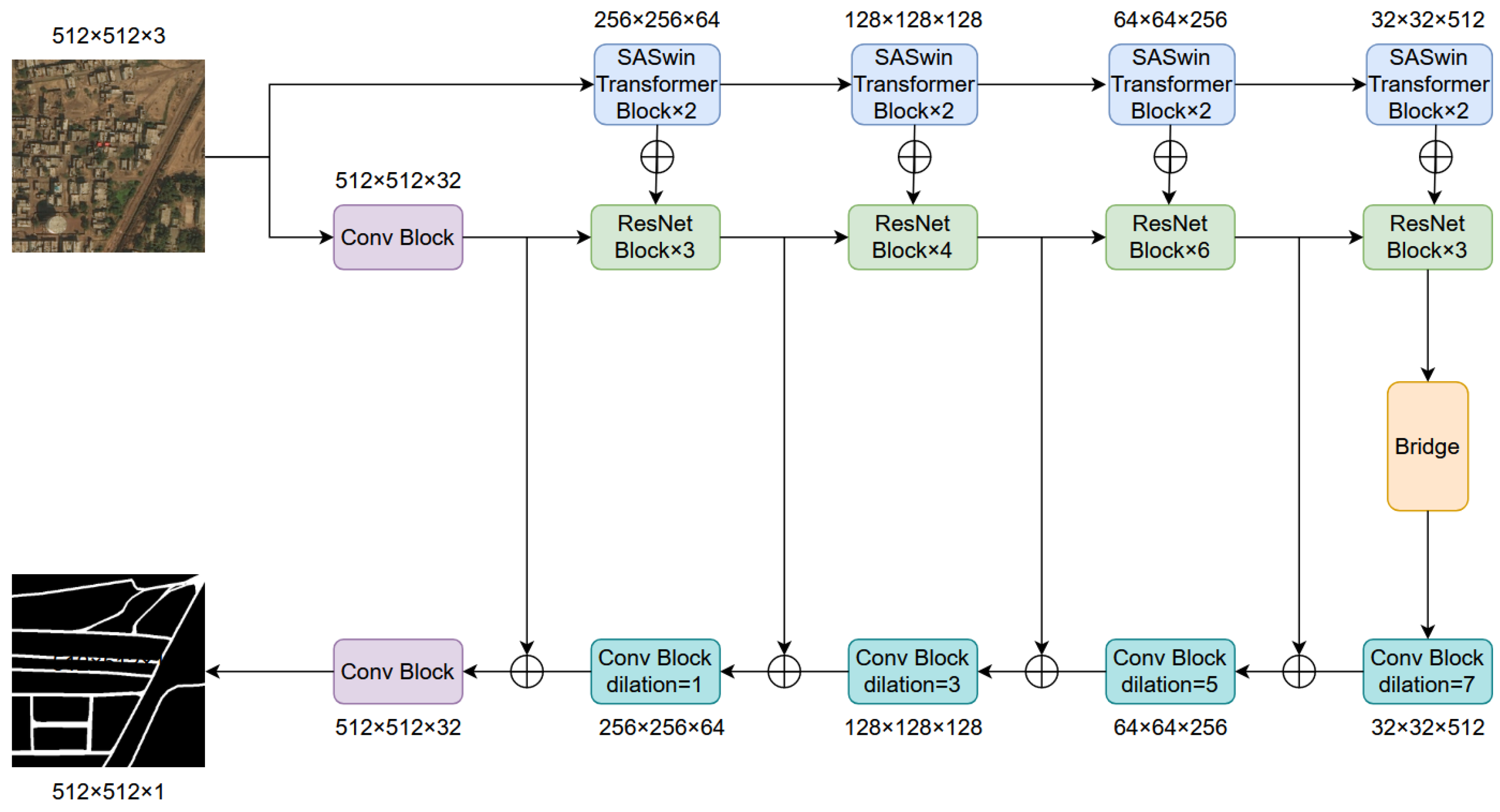
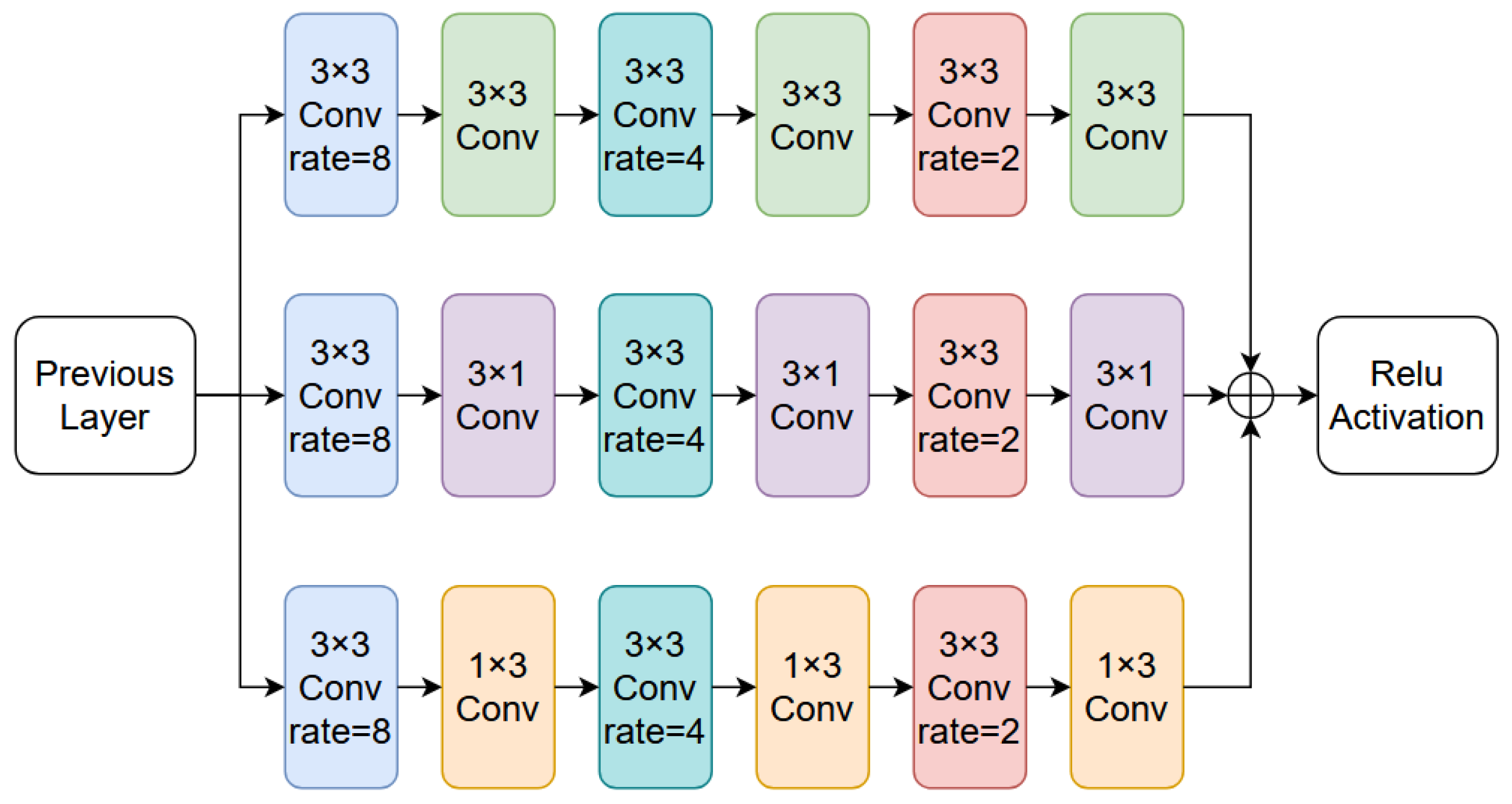
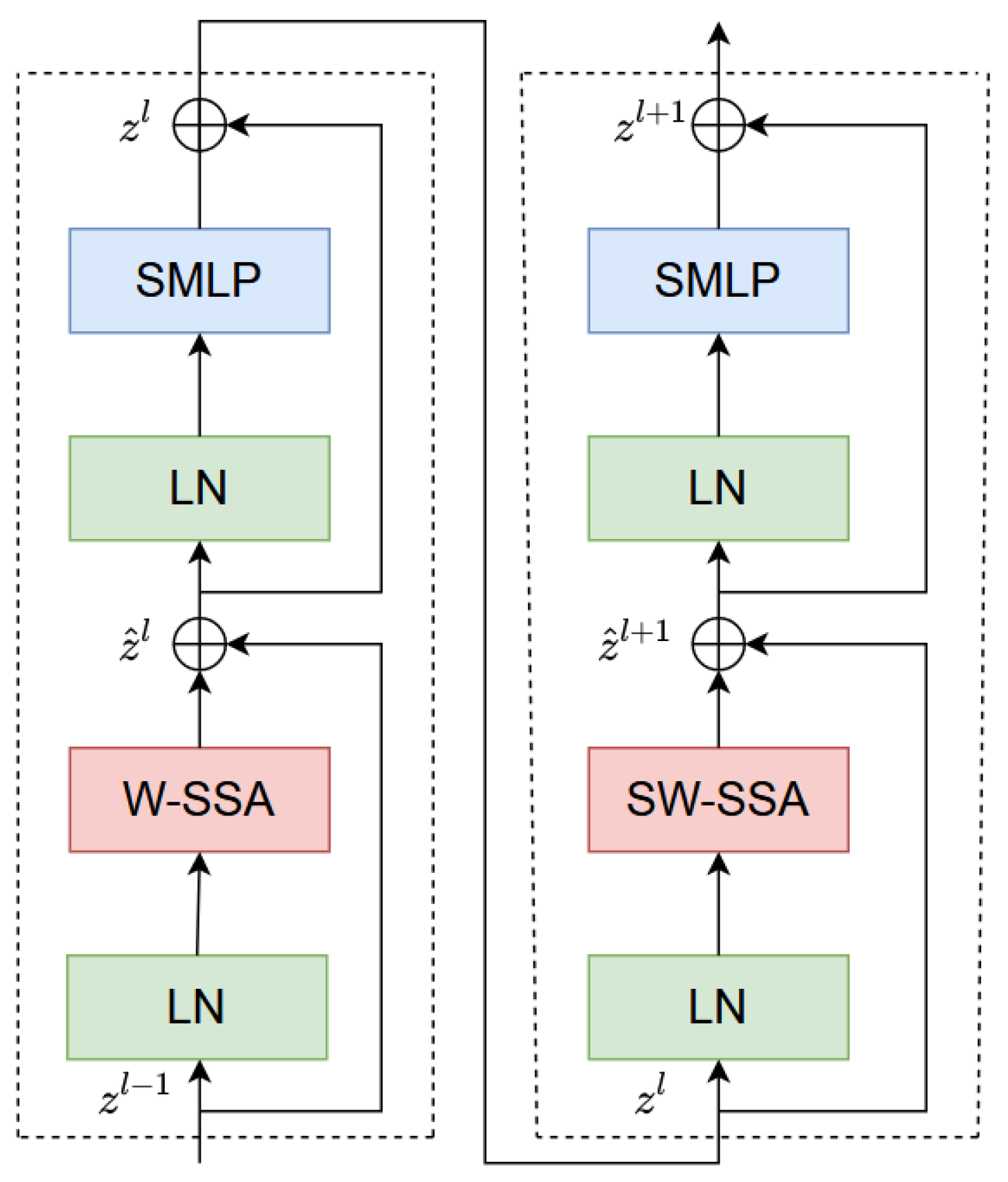
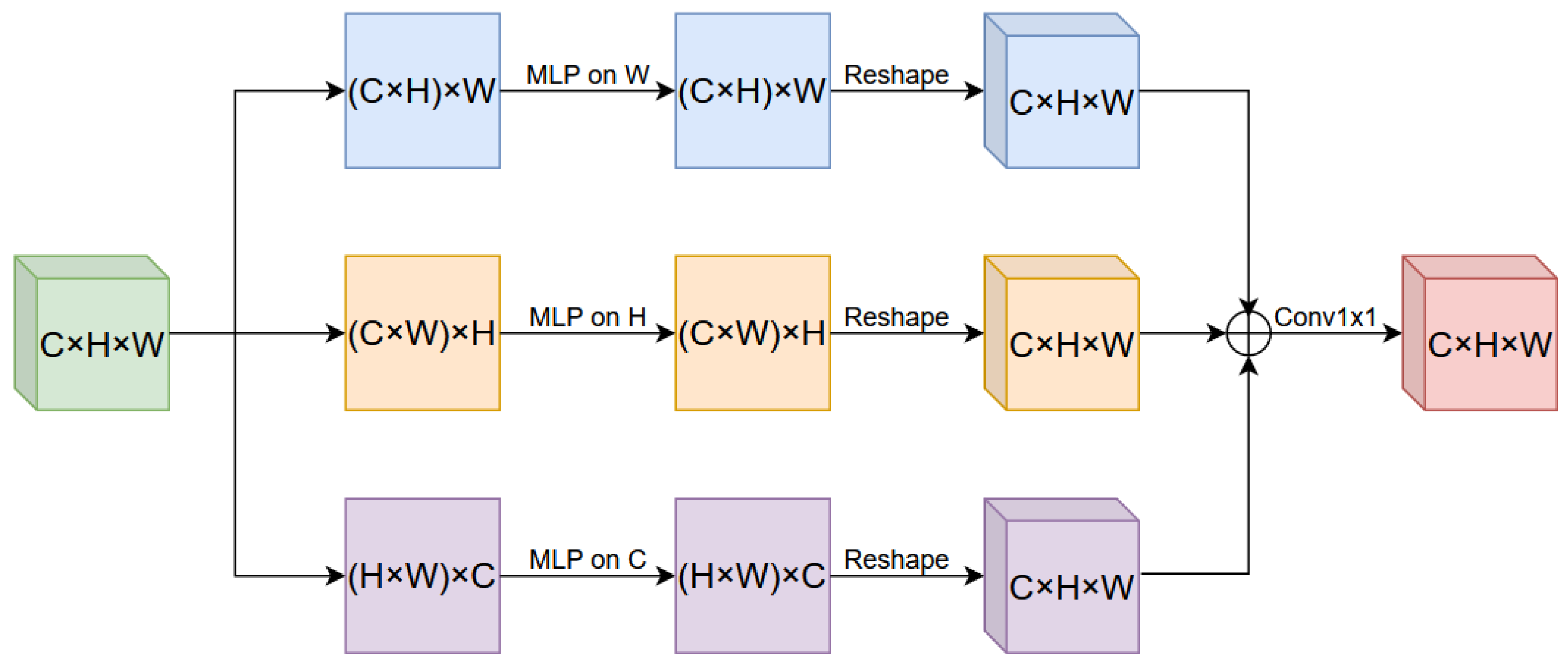
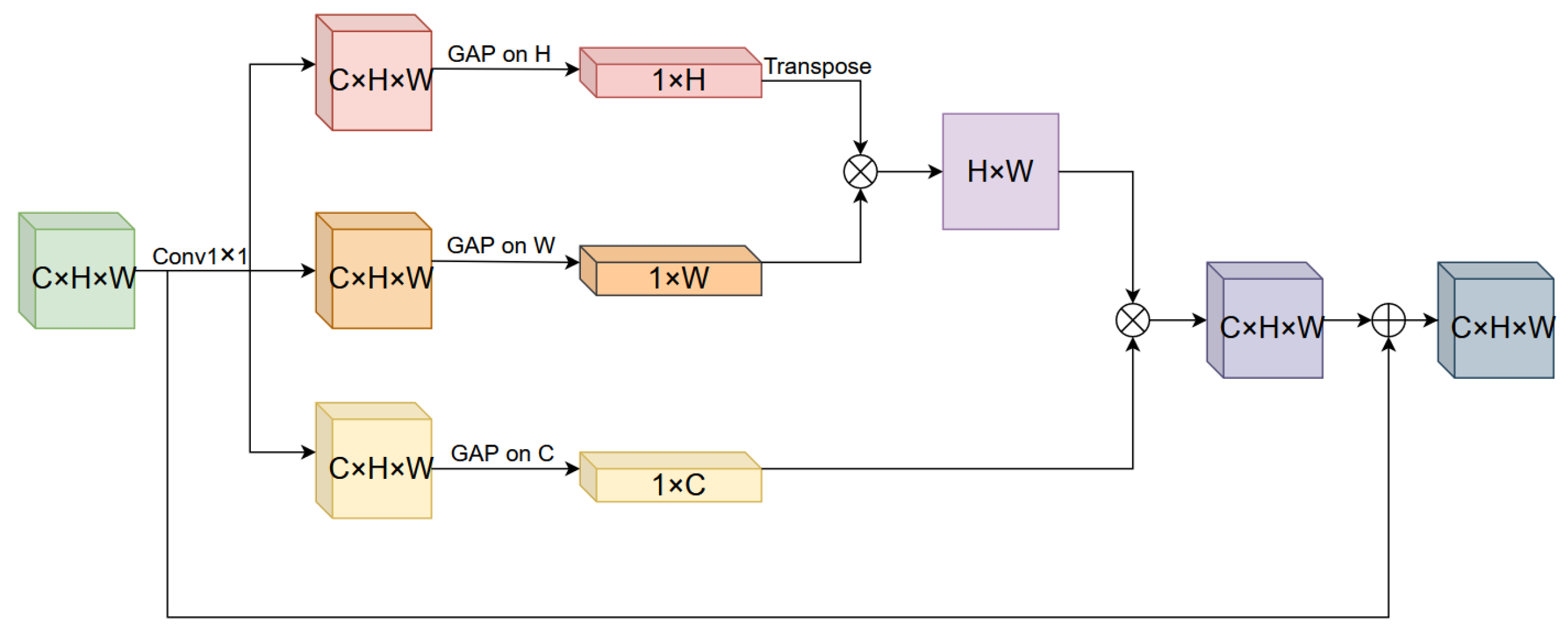
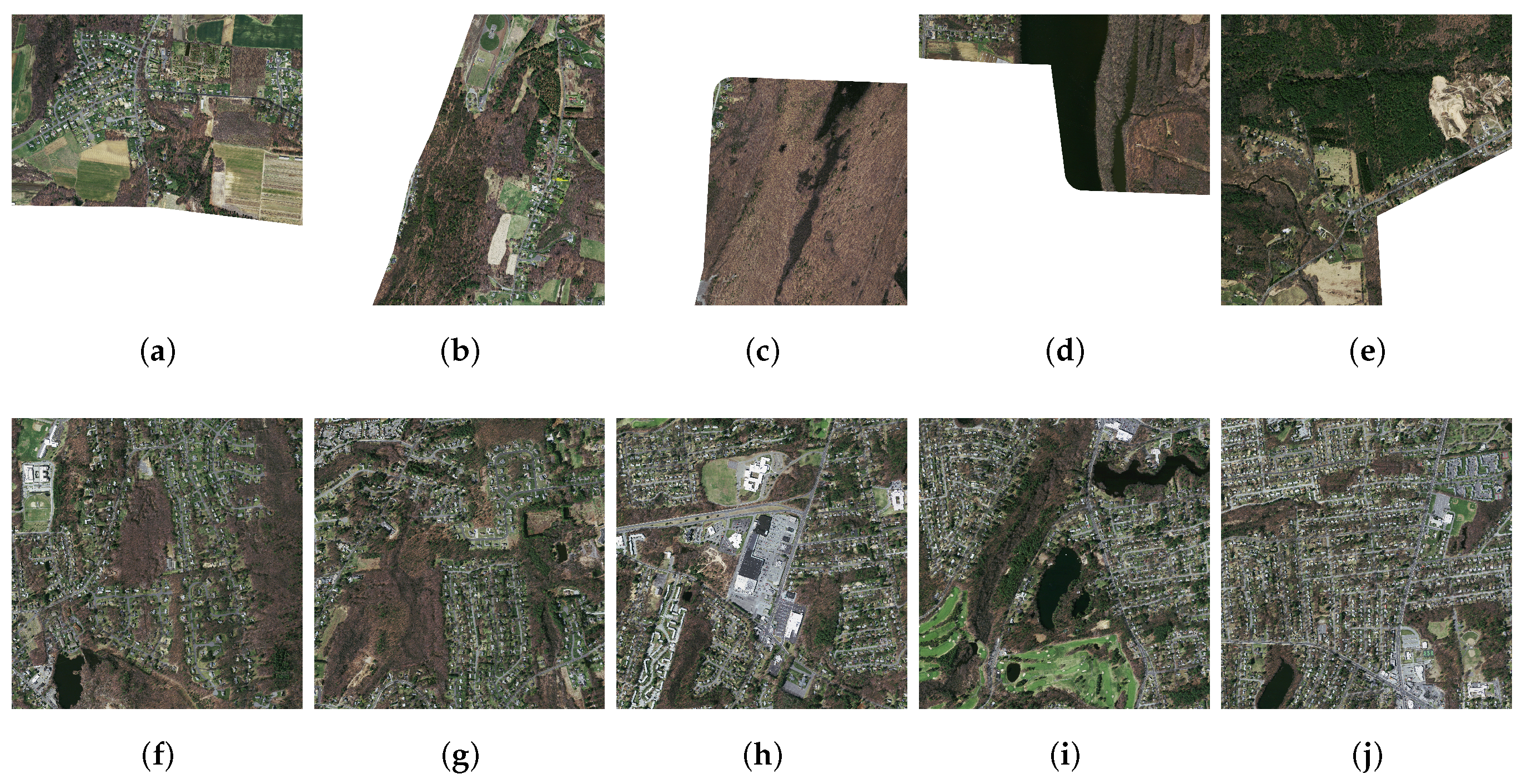

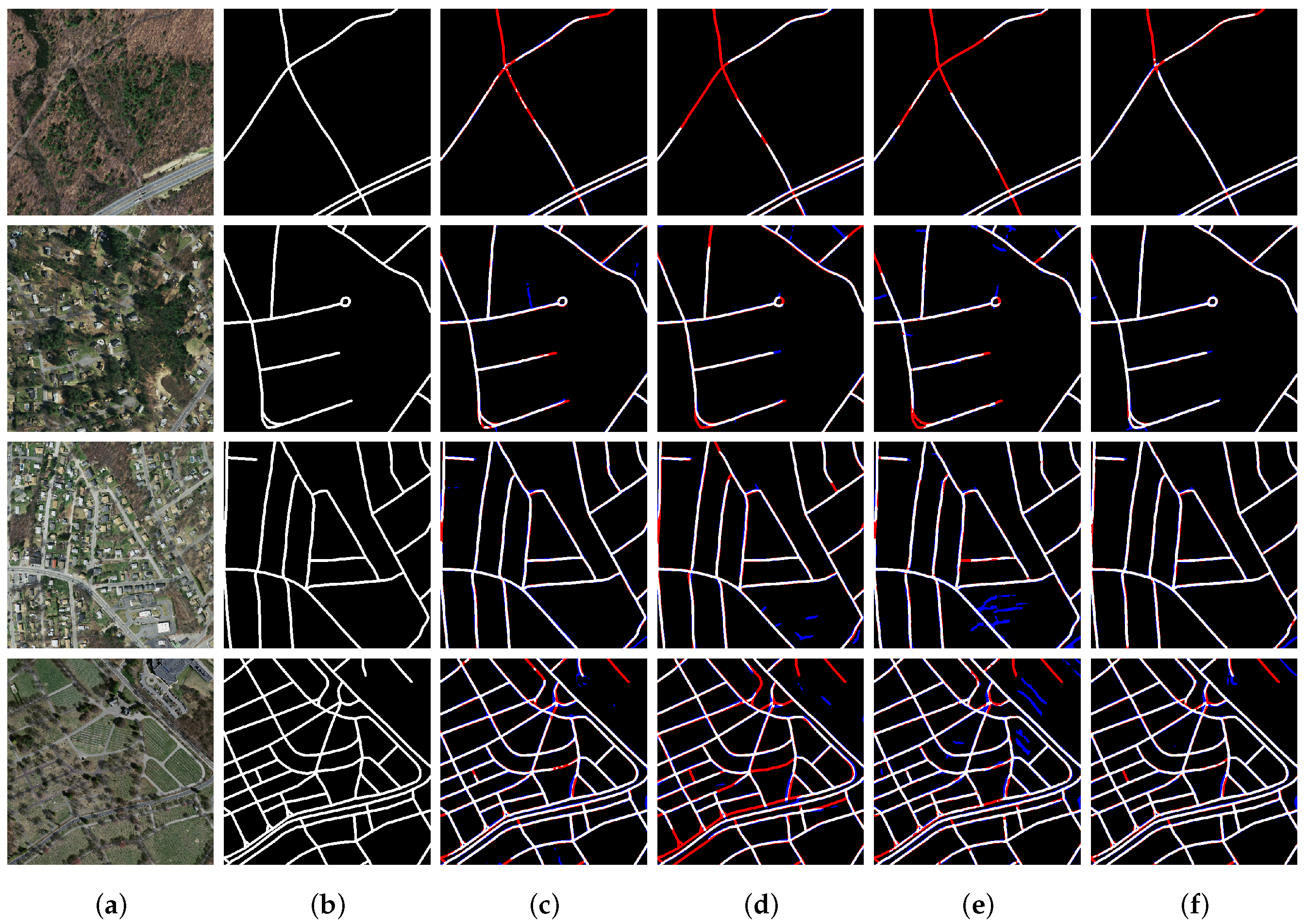
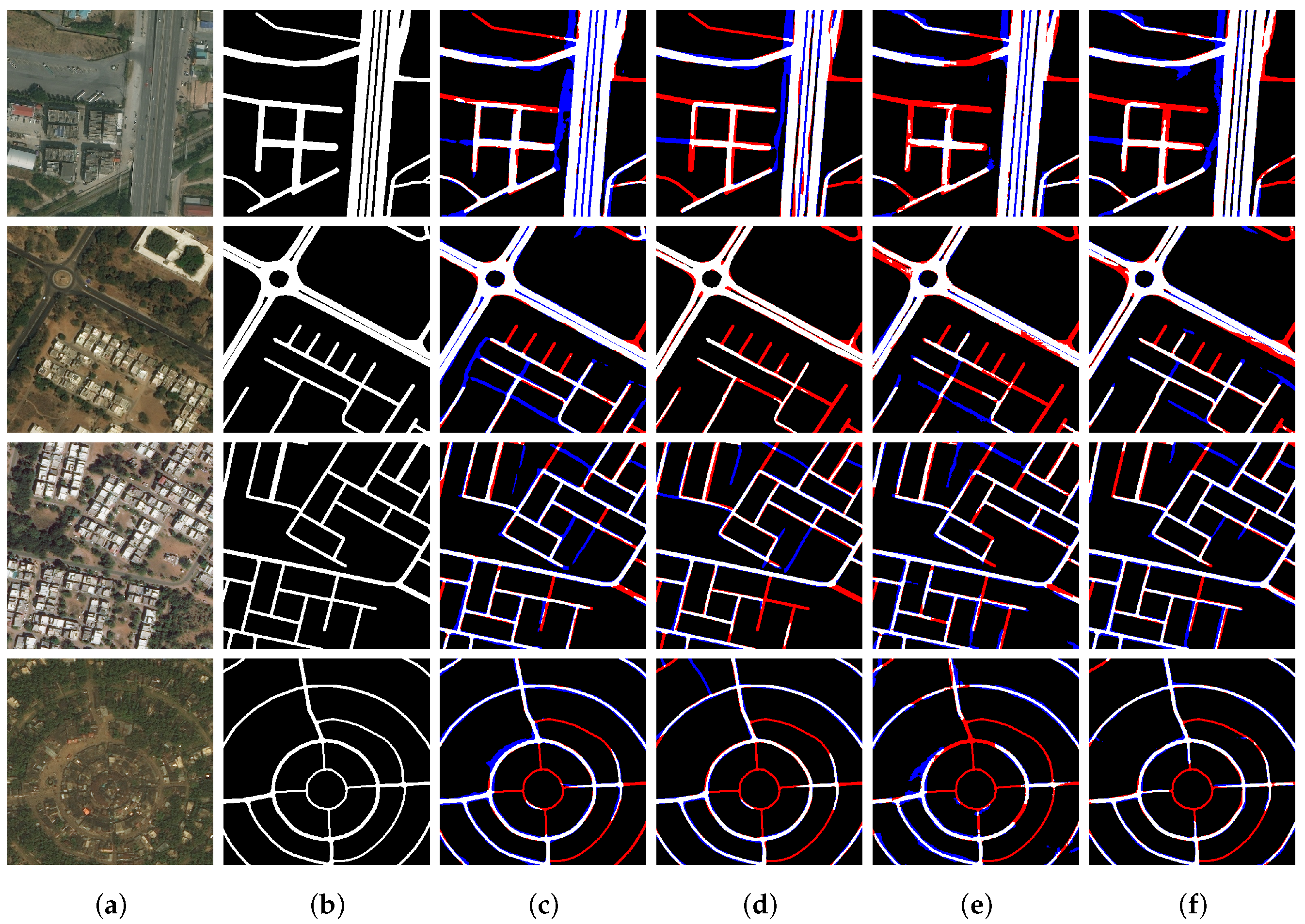
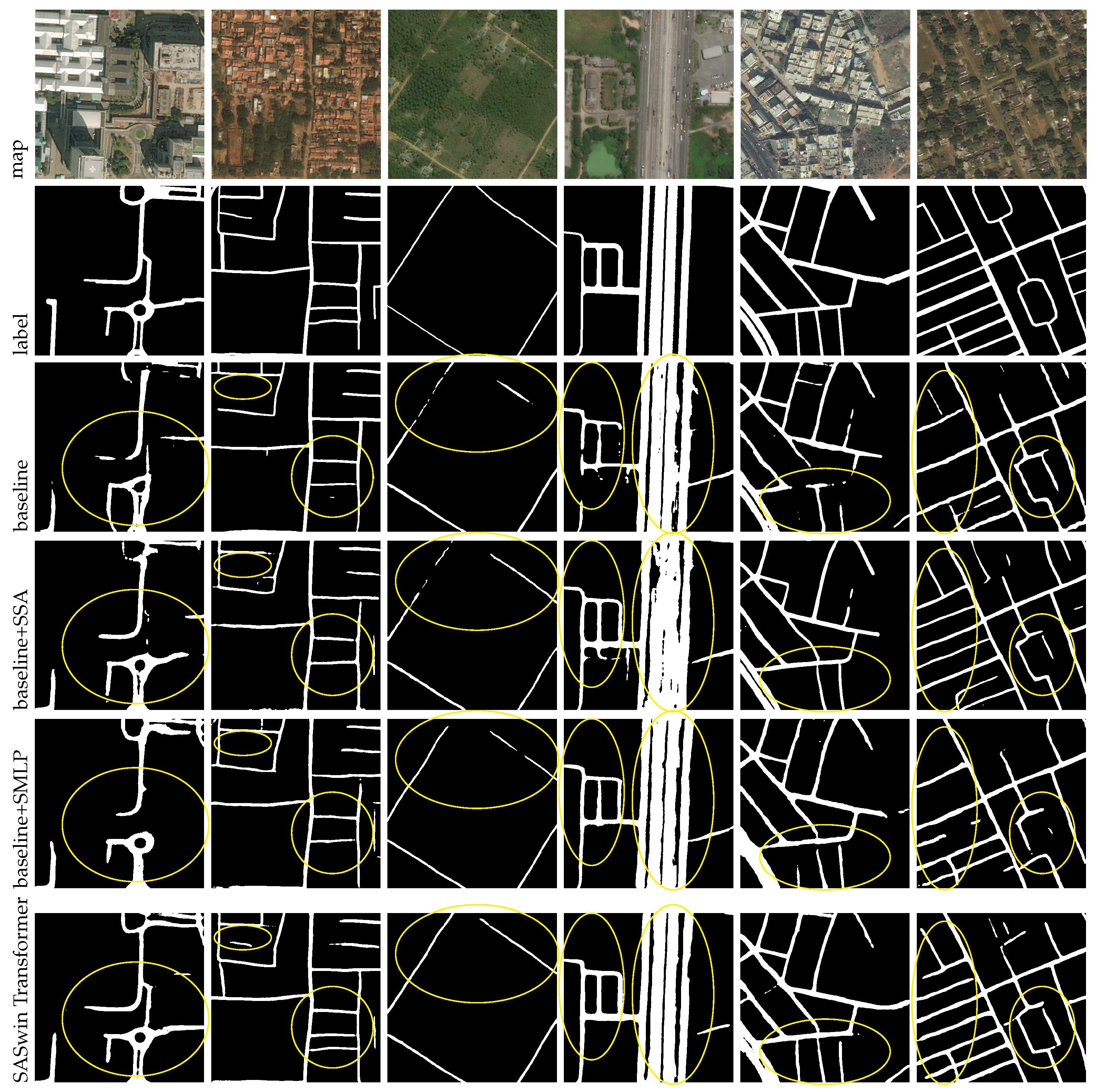
| Methods | P (%) | R (%) | F1 (%) | IoU (%) |
|---|---|---|---|---|
| FCN | 67.92 | 73.21 | 70.46 | 54.40 |
| UNet | 77.92 | 74.59 | 76.22 | 61.57 |
| ResUnet | 78.47 | 75.49 | 76.95 | 62.54 |
| SegNet | 78.17 | 76.16 | 77.15 | 62.80 |
| DeepLabV3 | 71.80 | 76.92 | 74.27 | 59.08 |
| LinkNet | 80.18 | 75.07 | 77.54 | 63.32 |
| D-LinkNet | 78.18 | 76.67 | 77.42 | 63.16 |
| CFPNet | 74.32 | 77.02 | 75.64 | 60.83 |
| TransUNet | 76.88 | 70.29 | 73.44 | 58.02 |
| SwinUnet | 75.27 | 73.40 | 74.32 | 59.14 |
| RoadExNet | 80.38 | 75.98 | 78.12 | 64.09 |
| RemainNet | 80.80 | 76.75 | 78.72 | 64.91 |
| SASwin Transformer | 80.02 | 77.65 | 78.82 | 65.04 |
| Methods | P (%) | R (%) | F1 (%) | IoU (%) |
|---|---|---|---|---|
| FCN | 78.29 | 70.92 | 74.42 | 59.26 |
| UNet | 80.16 | 73.82 | 76.86 | 62.14 |
| ResUnet | 76.94 | 76.42 | 76.68 | 62.18 |
| SegNet | 77.01 | 76.27 | 76.64 | 62.12 |
| DeepLabV3 | 74.72 | 77.75 | 76.11 | 61.43 |
| LinkNet | 77.80 | 77.02 | 77.41 | 63.14 |
| D-LinkNet | 78.44 | 77.30 | 77.87 | 63.76 |
| CFPNet | 74.61 | 74.92 | 74.77 | 59.70 |
| TransUNet | 79.30 | 73.81 | 76.46 | 61.89 |
| SwinUnet | 75.62 | 73.75 | 74.67 | 59.85 |
| RoadExNet | 74.31 | 78.09 | 76.16 | 61.49 |
| RemainNet | 76.94 | 79.42 | 78.16 | 64.15 |
| SASwin Transformer | 80.97 | 77.56 | 79.23 | 65.60 |
| Methods | P (%) | R (%) | F1 (%) | IoU (%) |
|---|---|---|---|---|
| Baseline | 78.86 | 76.48 | 77.65 | 63.47 |
| BaseLine + SMLP | 79.46 | 77.35 | 78.39 | 64.47 |
| Baseline + SSA | 79.87 | 76.73 | 78.27 | 64.30 |
| Baseline + SMLP + SSA | 80.02 | 77.65 | 78.82 | 65.04 |
| Methods | P (%) | R (%) | F1 (%) | IoU (%) |
|---|---|---|---|---|
| Baseline | 81.09 | 74.48 | 77.64 | 63.46 |
| BaseLine + SMLP | 81.59 | 74.50 | 77.88 | 63.78 |
| Baseline + SSA | 79.69 | 76.81 | 78.22 | 64.23 |
| Baseline + SMLP + SSA | 80.97 | 77.56 | 79.23 | 65.60 |
| Methods | Param (M) | FLOPs (G) |
|---|---|---|
| FCN | 45.5 | 83.7 |
| UNet | 34.2 | 124.4 |
| ResUnet | 14.1 | 324.1 |
| SegNet | 29.4 | 160.7 |
| DeepLabV3 | 39.6 | 164.1 |
| LinkNet | 11.5 | 12.1 |
| D-LinkNet | 31.1 | 33.6 |
| CFPNet | 0.5 | 4.0 |
| TransUNet | 106.2 | 31.2 |
| SwinUnet | 6.8 | 7.8 |
| RoadExNet | 31.1 | 33.87 |
| RemainNet | 33.6 | 60.9 |
| Baseline | 84.9 | 130.6 |
| SASwin Transformer | 79.9 | 127.5 |
| Methods | Massachusetts | DeepGlobe |
|---|---|---|
| FCN | ||
| UNet | ||
| ResUnet | ||
| SegNet | ||
| DeepLabV3 | ||
| LinkNet | ||
| D-LinkNet | ||
| CFPNet | ||
| TransUNet | ||
| SwinUnet | ||
| RoadExNet | ||
| RemainNet | ||
| Baseline | ||
| Baseline + SMLP | ||
| Baseline + SSA |
Disclaimer/Publisher’s Note: The statements, opinions and data contained in all publications are solely those of the individual author(s) and contributor(s) and not of MDPI and/or the editor(s). MDPI and/or the editor(s) disclaim responsibility for any injury to people or property resulting from any ideas, methods, instructions or products referred to in the content. |
© 2024 by the authors. Licensee MDPI, Basel, Switzerland. This article is an open access article distributed under the terms and conditions of the Creative Commons Attribution (CC BY) license (https://creativecommons.org/licenses/by/4.0/).
Share and Cite
Zhu, X.; Huang, X.; Cao, W.; Yang, X.; Zhou, Y.; Wang, S. Road Extraction from Remote Sensing Imagery with Spatial Attention Based on Swin Transformer. Remote Sens. 2024, 16, 1183. https://doi.org/10.3390/rs16071183
Zhu X, Huang X, Cao W, Yang X, Zhou Y, Wang S. Road Extraction from Remote Sensing Imagery with Spatial Attention Based on Swin Transformer. Remote Sensing. 2024; 16(7):1183. https://doi.org/10.3390/rs16071183
Chicago/Turabian StyleZhu, Xianhong, Xiaohui Huang, Weijia Cao, Xiaofei Yang, Yunfei Zhou, and Shaokai Wang. 2024. "Road Extraction from Remote Sensing Imagery with Spatial Attention Based on Swin Transformer" Remote Sensing 16, no. 7: 1183. https://doi.org/10.3390/rs16071183
APA StyleZhu, X., Huang, X., Cao, W., Yang, X., Zhou, Y., & Wang, S. (2024). Road Extraction from Remote Sensing Imagery with Spatial Attention Based on Swin Transformer. Remote Sensing, 16(7), 1183. https://doi.org/10.3390/rs16071183






